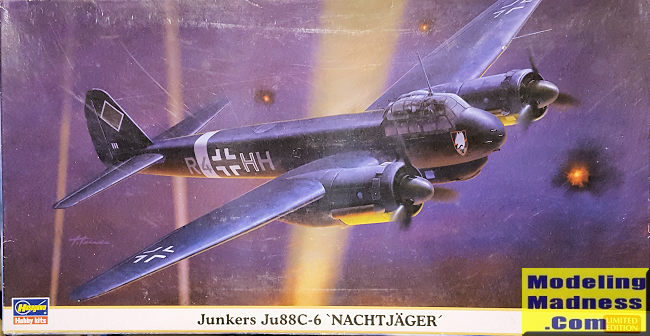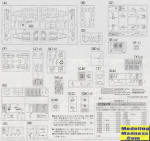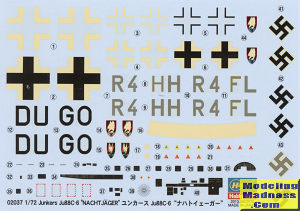
| KIT #: | 02037 |
| PRICE: | 3400 yen SRP |
| DECALS: | Three options |
| REVIEWER: | Scott Van Aken |
| NOTES: | 2013 Limited Edition. |

| HISTORY |
The Ju 88C was originally intended as a fighter-bomber and heavy fighter by adding fixed, forward-firing guns to the nose while retaining some bomb carrying ability of the A-series bomber. The C-series had a solid metal nose, typically housing one 20 mm MG FF cannon and three 7.92 mm (.312 in) MG 17 machine guns. The aircraft retained the ventral Bola gondola under the crew compartment though individual units sometimes removed this to reduce weight and drag to enhance performance. The Ju-88C was later used as a night fighter, and this became its main role.
The first version of the Ju 88C was the C-1 with 20 aircraft converted from A-1 airframes. Some of them entered service in the Zerstörerstaffel of KG 30 which became part of II./NJG 1 in July 1940. The C-1 was followed by the C-2 of which 20 aircraft were converted from A-5 airframes with enlarged wingspan. The C-4 became the first production version with 60 produced and 60 converted from A-5 airframes. The C-6, of which 900 aircraft were produced, was based on the A-4 airframe with more powerful engines and stronger defensive armament (single- or dual-mount belt-fed 7.92 mm MG 81 or 13 mm MG 131 instead of drum-fed MG 15 machine guns).The C-6 as night fighter was typically equipped with FuG 202 Lichtenstein BC low-UHF band airborne intercept radar, using the complex 32-dipole Matratze antennas. The first four C-6 night fighters were tested in early 1942 by NJG 2. The trials were successful and the aircraft was ordered into production. In October 1943, many C-6s were upgraded with new radar systems. The first new radar equipment was the FuG 212 Lichtenstein C-1. After the UHF-band Lichtenstein radars had been compromised to the Allies in the late spring of 1943, the next development in German AI radar was the VHF-band FuG 220 Lichtenstein SN-2, discarding the 32-dipole Matratze antennae for the much larger eight-dipole Hirschgeweih (stag's antlers) aerials, required for the longer wavelength SN-2 system.
Many Ju-88C's had their Bola gondolas modified to hold up to two forward firing 20 mm cannons. Several C-6 night fighters were equipped with two "Schräge-Musik" upward-firing 20mm cannons in trial fittings, and from mid 1943 onward, there was an official field modification kit available for this arrangement.
A small number of the C-series day fighters had their new solid-metal noses specially painted to resemble the bomber A-series' "beetle's eye" faceted clear view nose glazing, in an attempt to deceive Allied pilots into thinking the fighters were actually bombers; the unusual "camouflage" attempt did result initially in a number of Allied aerial losses.
| THE KIT |
 Any
more, a major kit manufacturer will not expend the resources on a kit unless
they can do multiple variants. The Ju-88 is a perfect subject for this as it was
done in multiple variants, each of which was used by a large number of units.
This allows for a large number of Limited Editions based on the Ju-88A-4 basic
boxing. Hasegawa has done a good job of following this and so you have a kit
that has a lot of subassemblies and inserts. While I wish they'd do an A-5 or
A-1 variant, that requires different wings so Hasegawa has not gone that route
yet. Too bad as those variants were the most used in the early war and the
Battle of Britain. For that, you need to go to Revell.
Any
more, a major kit manufacturer will not expend the resources on a kit unless
they can do multiple variants. The Ju-88 is a perfect subject for this as it was
done in multiple variants, each of which was used by a large number of units.
This allows for a large number of Limited Editions based on the Ju-88A-4 basic
boxing. Hasegawa has done a good job of following this and so you have a kit
that has a lot of subassemblies and inserts. While I wish they'd do an A-5 or
A-1 variant, that requires different wings so Hasegawa has not gone that route
yet. Too bad as those variants were the most used in the early war and the
Battle of Britain. For that, you need to go to Revell.
This is the C-6 version with the solid nose and a few other differences, but as mentioned, it is basically very much like the basic boxing A-4. There are three markings options, which are all quite similar. However, one of the options takes the double rear guns and the other two take the single, so you do need to be aware of that. None of these have radar, even though they are night fighters. They also have early flame dampers. As expected, the nose is separate from the rest of the fuselage and since this does not have a bomber nose, the various small windows in the lower nose will need to be installed and filled in. The nicely done interior uses decals for instruments and this is adequate for the scale.
Two hefty wing spars are installed to help keep the wings properly aligned. Both options are Jumo powered so you get those engine nacelles. Note also that the wing tips are separate items and are among the more difficult pieces to get properly aligned. There are some holes you'll need to open in the lower fuselage and that is shown in the instructions. One nice thing is that you can install the main landing gear after the kit is painted. The tail gear gets trapped between the fuselage halves so you'll need to mask that off
As usual, the clear bits will be a challenge. I highly
suggest a masking set and care with installation. One thing to keep in mind
regarding masking sets is that all the ones I've seen are for the single rear
defensive gun so you might want to get a standard Ju-88A-4 set for the double
gun version. I've built a couple of Hasegawa Ju-88s and while they
do have a goodly number of inserts, they are fairly straight-forward builds.
Instructions are well done with the usual Gunze paint references. The first two options are listed as the early versions and are in overall black and with NJG 2. The box art option has yellow lower engine cowlings for operations in Sicily. The third option is your standard night fighter scheme of overall RLM 76 with large RLM 75 splotches on the upper surface. This is a later version and is fitted with Shrage Musik upward firing guns. Decals are old school with off-white white areas and should be replaced. At least the insignia and the fuselage band. As with all Hasegawa's Ju-88s, you are provided decals for the cockpit instrumentation.
| CONCLUSIONS |
This is a very good kit and well worth building. I bought this from a person I'd bought kits from before, and it was listed as unstarted. That was true. However, all the parts had been cut from the sprues and put into a bag. The box top and bottom had been folded to fit flat and save space. This was the third of three kits I bought from this person that was so delivered. To say I'm less than pleased would be about right and this will stop me from ever buying anything from him again. I have built Ju-88s in this scale from everyone who has kitted one except the new Revell version, and my first choice is still the Hasegawa offering.
March 2021
Copyright ModelingMadness.com. All rights reserved
If you would like your product reviewed fairly and fairly quickly, please
contact
the editor or see other details in the
Note to
Contributors. Back to the Main Page
Back to the Review
Index Page
Back to the Previews Index Page